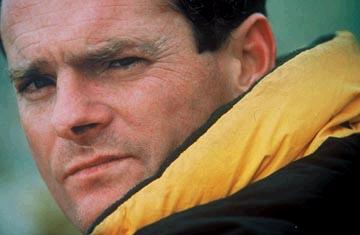

In 1985, two friends, Joe Simpson and Simon Yates set out to climb Suila Grande, an imposing snow covered peak that reaches nearly 21,000 feet in the Peruvian Andes. Their harrowing experiences over the next week were chronicled in Simpson's book Touching the Void, and shot here by documentarian Kevin MacDonald (One Day in September, A Brief History of Errol Morris). Since there were no cameras present on the original climb, MacDonald has actors recreate the climb while Simpson and Yates narrate. It sounds potentially corny, but is, in fact, highly dramatic. The actors look nothing like Simpson and Yates. Moreover, Simpson is right there on screen, narrating the feature. Yet, MacDonald deftly combines the recreation with the actual figures that while its obvious that Simpson survives somehow, the tension and drama of watching his ordeal makes people forget he is there, and everybody is caught up in his fight for survival.
The duo, then in their twenties aspired to climb the west face of Suila Grande, something that had yet to be accomplished. As mountain climbers, they wanted to scale Suila Grande because it was there. It was the thrill of the climb, and the fact that nobody had ever done this particular route before. They mapped out their course, climbing dangerously past and over glaciers deep chasms, battling the effects of exhaustion and dehydration. Yates (Nicholas Aaron, The Initiation of Samuel Caine, Lemmings) typically led, while Simpson (Joe Mackey, Boxed, H3) brought up the rear. They climbed "alpine style," which is a more "pure" form of climbing. There are no oxygen tanks, fixed camps along the way, and no support teams. Everything they bring is on their back, and they only have each other to rely on.
They did make it to the top, but it proved more difficult than they initially imagined. The way down proved worse. At one point during the descent, Simpson falls and breaks his leg. There is nobody around to help either of them, and with a storm coming in, they are both potentially dead. Yates works out a system where he lowers Simpson with a rope down a slope, then moves forward to him, then they repeat the process. It is painfully slow, but is their best chance for survival. At least until Yates unknowingly lowers Simpson over a 300 foot drop. Yates cannot see the drop, he only knows that the rope remained taut when it was supposed to go slack. After much soul-searching, he cuts the rope, dropping Simpson into a crevasse, and makes is way down the mountain.
The remainder of Touching the Void is the most gripping. Yates must deal with his actions. He has immense guilt over what he believes is the death of his friend. If he didn't cut the rope, both of them would be dead. Meanwhile, against all odds, Simpson is alive, and even more miraculously, has the strength to find and crawl his way out of the crevasse and down the mountain. MacDonald switches between head-shots of the two men recounting their experiences and shots of the actors recreating the scenes. Simpson and Yates are well-spoken and speak matter-of-factly, without too much embellishment. However, their words are enough, as the material is riveting. The mix between documentary and film really works here, elevating the level of tension to near-excruciating.